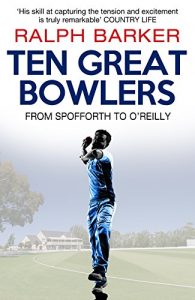While the perfect cricketer is a character, modest in success and serene in failure, as a bowler he must have hostility, capable of turning a match with a single ball…
Take J. Barton King of Philadelphia, a wisecracking showman and pioneer of swing bowling, whose efforts in 1893 were instrumental in defeating a visiting Australian team.
Or Maurice Tate, who, during the opening innings of the 1924-5 Ashes’ First Test, continued bowling and took six wickets despite having driven his big toe-nail back into the toe?
From F. R. Spofforth’s score with W. G. Grace to C. V. Grimmett’s dogged determination, such acts can define Test Matches, and careers.
To this day George Lohmann remains the fastest entrant into the 100 wicket club, while the fates of W. H. Lockwood and Tom Richardson seemed bound together.
And not forgetting S. F. Barnes, the Bradman of bowlers, or W. J. O’Reilly, considered the best and most dangerous bowler in the world when he came to England in 1938.
But how did they operate? What made them great? How did they get great batsmen out?
In his Foreword A. V. Bedser says, “these great bowlers had their own method of bowling and developed their natural talents. In fact they were not cast in a mould or stereotyped.”
Like Hedley Verity, who painstakingly practised new stratagems before unleashing them at the crease, they all mastered the art of bowling, and their names will live forever.
‘It is improbable that anyone has before written such vivid and accurate descriptions of the game’s purple patches. His skill at capturing the tension and excitement is truly remarkable.’ — Country Life
‘Painstaking research coupled with real insight into the temperaments of his heroes gives a peculiarly graphic quality to his writing.’ — Sunday Times
‘Few are the cricket books that contain any writing of interest or value. This is an exception. Mr. Barker writes good prose and he gives the impression that he has watched every ball.’ — Times Literary Supplement
‘A superb book for the cricket enthusiast. The ten innings are brilliantly described.’ — J. C. Laker
‘His versions have the satisfactory roundness and wholeness of brilliantly written short stories.’ — The Field
‘Stories of skill, patience, grit and swashbuckling verve retold in an urgent, compelling style. You are there on the terraces; in the game.’ — Times Educational Supplement
‘He has superbly re-created the atmosphere and excitement of ten great innings.’ — Daily Express
Ralph Barker (1917-2011) started work as a sporting journalist in 1934. He joined the RAF in 1940 as an air-gunner, and subsequently worked in the RAF Historical Branch and in Intelligence, before retiring in 1961 to write full time. Cricket was his life-long passion and his other works include: Down in the Drink, The Ship-Busters, Strike Hard, Strike Sure, The Thousand Plan, Great Mysteries of the Air, One Man’s Jungle, Not Here, But in Another Place and The Cricketing Family Edrich.
Take J. Barton King of Philadelphia, a wisecracking showman and pioneer of swing bowling, whose efforts in 1893 were instrumental in defeating a visiting Australian team.
Or Maurice Tate, who, during the opening innings of the 1924-5 Ashes’ First Test, continued bowling and took six wickets despite having driven his big toe-nail back into the toe?
From F. R. Spofforth’s score with W. G. Grace to C. V. Grimmett’s dogged determination, such acts can define Test Matches, and careers.
To this day George Lohmann remains the fastest entrant into the 100 wicket club, while the fates of W. H. Lockwood and Tom Richardson seemed bound together.
And not forgetting S. F. Barnes, the Bradman of bowlers, or W. J. O’Reilly, considered the best and most dangerous bowler in the world when he came to England in 1938.
But how did they operate? What made them great? How did they get great batsmen out?
In his Foreword A. V. Bedser says, “these great bowlers had their own method of bowling and developed their natural talents. In fact they were not cast in a mould or stereotyped.”
Like Hedley Verity, who painstakingly practised new stratagems before unleashing them at the crease, they all mastered the art of bowling, and their names will live forever.
Praise for Ralph Barker
‘It is improbable that anyone has before written such vivid and accurate descriptions of the game’s purple patches. His skill at capturing the tension and excitement is truly remarkable.’ — Country Life
‘Painstaking research coupled with real insight into the temperaments of his heroes gives a peculiarly graphic quality to his writing.’ — Sunday Times
‘Few are the cricket books that contain any writing of interest or value. This is an exception. Mr. Barker writes good prose and he gives the impression that he has watched every ball.’ — Times Literary Supplement
‘A superb book for the cricket enthusiast. The ten innings are brilliantly described.’ — J. C. Laker
‘His versions have the satisfactory roundness and wholeness of brilliantly written short stories.’ — The Field
‘Stories of skill, patience, grit and swashbuckling verve retold in an urgent, compelling style. You are there on the terraces; in the game.’ — Times Educational Supplement
‘He has superbly re-created the atmosphere and excitement of ten great innings.’ — Daily Express
Ralph Barker (1917-2011) started work as a sporting journalist in 1934. He joined the RAF in 1940 as an air-gunner, and subsequently worked in the RAF Historical Branch and in Intelligence, before retiring in 1961 to write full time. Cricket was his life-long passion and his other works include: Down in the Drink, The Ship-Busters, Strike Hard, Strike Sure, The Thousand Plan, Great Mysteries of the Air, One Man’s Jungle, Not Here, But in Another Place and The Cricketing Family Edrich.












